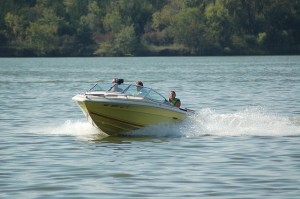How To Prevent Your Boat From Porpoising
 Does your boat ‘bounce’ when you reach a certain speed on the water? Known as porpoising, this phenomenon typically occurs when a boat is traveling at a high rate of space with the incorrect trim setting. Normally, porpoising is prevented by making the necessary trim adjustments. If the setting is wrong, however, or the trim is damaged/malfunctioning, the boat may continue to bounce up and down in a characteristic porpoise-like motion.
Does your boat ‘bounce’ when you reach a certain speed on the water? Known as porpoising, this phenomenon typically occurs when a boat is traveling at a high rate of space with the incorrect trim setting. Normally, porpoising is prevented by making the necessary trim adjustments. If the setting is wrong, however, or the trim is damaged/malfunctioning, the boat may continue to bounce up and down in a characteristic porpoise-like motion.
What Causes Porpoising?
Porpoising is the result of the motor’s outdrive pushing the boat upwards, essentially boosting it out of the water – albeit for a short period of time. Once the boat comes back down, the outdrive will once again push it back out of the water. This cycle will continue to repeat until either the boat’s speed is reduced or the trim is fixed.
Allowing a boat to porpoise is a serious hazard that can leave both the captain and his or her passengers at risk for injury. There have been countless injuries reported due to severe porpoising, so don’t overlook this element with your boat.
Stopping The Porpoising Effect
So, what’s the best approach to fixing a boat’s porpoising effect? Unless you want to reduce your speed, you must adjust the trim to prevent this effect from occurring. Access the trim controls on your boat and gradually lower it until the boat is no longer bouncing out of the water. It’s important to note that lowering your trim too low will result in a loss of speed, which is something most people want to avoid; therefore, you should lower it just slightly until you find a happy medium in which you maintain your speed but no longer experience the porpoising effect.
Not All Boats Porpoise Equally
While porpoising may occur with any powered watercraft, it’s far more common in boats with inboard/outboard or propeller-driven outboard motors. If your boat falls under one of these two categories, be prepared to adjust the trim when operating at high speeds.
It’s also worth mentioning that there’s no such thing as a universal trim setting. The appropriate trim varies depending on the boat’s hull design, size and weight. If you recently unloaded a large amount of heavy gear off your boat, chances are you’ll need to adjust the trim once more. The lighter load will directly affect how much “bounce” your boat has. In order to stop this bounce, the trim must be adjusted to fit your boat’s new weight.
